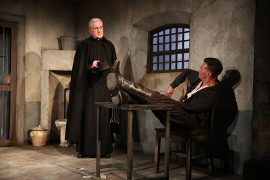
Glenda
Frank
KINGFISHERS CATCH FIRE
“Kingfishers
Catch Fire” by Robin Glendinning, directed by Kent Paul Robin Glendinning has set “Kingfishers Catch Fire,” his remarkable two-hander in a cramped prison cell in Rome, Italy, after World War II. Monsignor Hugh O’Flaherty, a Vatican priest who worked with the Resistance, is visiting Herbert Kappler (Haskell King), nicknamed “The Beast,” a Nazi war criminal condemned to life imprisonment only because Italy has outlawed the death penalty. O’Flaherty says God told him to visit but during their conversation, we learn that the priest attended Kappler’s trial and was astonished to hear him confess, condemning himself in sworn testimony. He has come to take the measure of his most formidable enemy. World War II is a still a favorite for movies, theatre, even television. Nazis make good drama and comedy, from Chaplin’s “The Great Dictator” and Broadway’s “The Producers” to “Inglourious Basterds” and “Schindler’s List.” What make “Kingfishers Catch Fire” unique are the revelations, the factors motivating each man and his ability to hear the other. Labeling people makes the world more comprehensive: villain, hero, coward, deplorable. But people are often more shades of gray than black and white. Glendinning in no way excuses or exonerates “The Beast.” He bares him for us to understand the monster, even as he humanizes him. He also humanizes the hero who saved over 6500 thousands allied soldiers and Jews, earning him the nickname The Scarlet Pimpernel of the Vatican. Monsignor Hugh O’Flaherty’s favorite story is dressing up as a coal deliverer and slipping by the Gestapo, who had surrounded the Vatican. The Pope had signed a neutrality pact in exchange for the safety of the Vatican, which was demarked by a white line. Any priest on the wrong side of the line would be executed. When the church superiors got wind of his Resistance work, O’Flaherty promised to stop, but continued in secret. That, the celebrity that came after the war, and his own penchant for storytelling led to his clerical unpopularity (perhaps even ostracism) after the war and may have squelched his promotion to bishop. Ignoring his conscience, Kappler followed order to the word. Knowing nothing of the Final Solution, he told Berlin they had nothing to fear from the Jews in Rome and should not target them. But when the order for removal came, he complied. To keep order, he shot mothers who marched for bread for their children. His greatest crime was in the Ardeatine Caves, where he executed 335 Italians because the Resistance had killed 10 soldiers, among them a boy his son’s age, a boy who haunts him. He knows his crimes. The inspiration for the play came when Caves. “I had no words, no poetry, no music, even no thoughts and I simply knelt. In another cave the 335 victims were in their coffins, each on his plinth . . . as if some spiritual bugle will wake them.” The title comes from a poem by another priest, Gerard Manly Hopkins. Lines read: “What I do is me . . . /The just man justices/. . . [He acts] in God’s eye what in God’s eye he is.” The stage play is an adaptation of Glendinning’s 2006 radio play, “The Scarlet Pimpernel of the Vatican.” “Kingfishers Catch Fire” is an exploration of choices
and contradictions. The power of the drama lies in these contradictions,
which are peeled free layer by layer in their conversations. Sean
Gormley seems a little too pleasant for a Resistance fighter, and
Haskell King too young for Kappler. (I would have appreciated a
consistent, strong German accent.) Despite this, the pace is good,
the set by Edward Morris evocative, and the drama is very moving.
|
| recordings | coupons | publications | classified |

